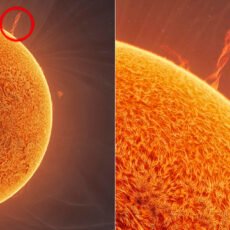
NASA shows us what the annular solar eclipse on October 14 looked like from space, as captured by the EPIC (Earth Polychromatic Imaging Camera) imager aboard the DSCVR (Deep Space Climate Observatory). This phenomenon occurs when the Moon passes in front of the Sun, but is too far from Earth to completely obscure it.
When the Moon is at or near its farthest distance from Earth, called apogee, during an annular eclipse, it appears smaller in the sky. This leaves the Sun’s edges exposed in a red-orange ring, better known as the “ring of fire.” The EPIC imager managed to capture an earthly view of the event, as the Moon’s shadow crossed North America.
- INSPIRE CURIOSITY – The NASA Lunar Telescope allows your child to see the moon in incredible detail; the perfect gift for girls and boys interested...
- HIGH-QUALITY OPTICAL GLASS AND FINDER SCOPE – This easy-to-use telescope comes with a finder scope, low power, and high-power eyepieces; when used...
- TABLETOP TRIPOD & SMOOTH MOUNT SYSTEM – Use the included tripod to steady your Lunar Telescope for optimal viewing, with a smooth mounting system...


The map above, developed by NASA’s Scientific Visualization Studio, shows the dark path of the annularity stretching across the lower 48 states from Oregon to Texas. The map uses datasets from several NASA missions. Imagery from MODIS (Moderate Resolution Imaging Spectroradiometer) instruments on the Terra and Aqua satellites was the source of the Blue Marble Next Generation composite used to depict the terrain,” said Emily Cassidy, Editor for NASA’s Earth Science Data Systems Program.










